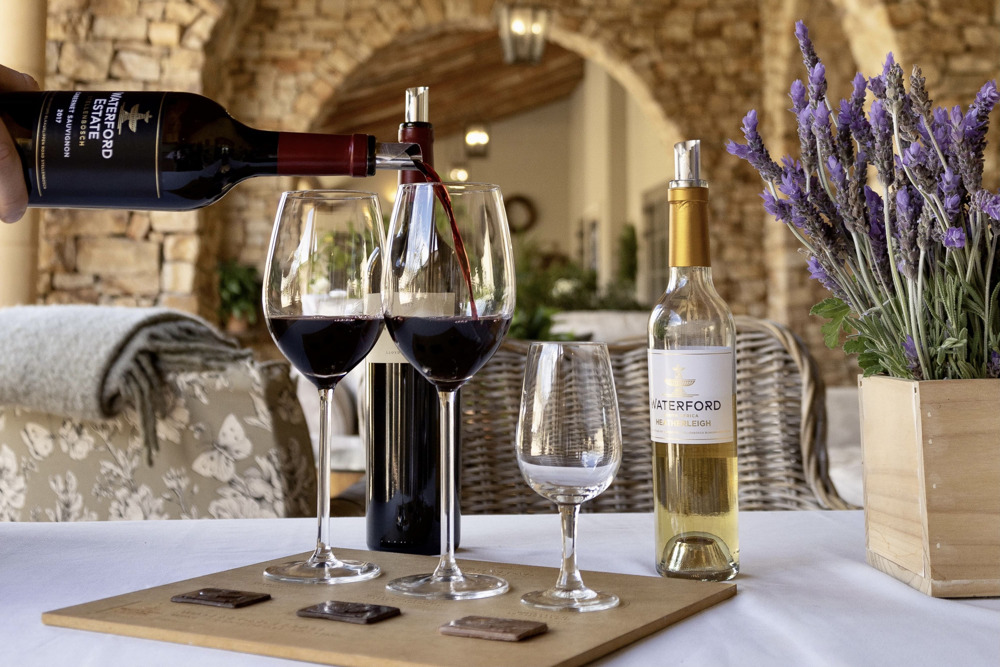Waterford Estate The Jem - The poetry of winemaking
Thursday - 5 January 2023

Crafting something memorable isn’t done in a day, it is achieved through commitment, a
dedication to perfection, and a passion like none other.
Tasting a bottle of wine crafted from a specific vintage and a specific region is like tasting a time
capsule for the year - it's a look into the conditions of that year, the higher or lower rainfall, the
heat or the cold - this is the poetry of winemaking.
Whether you are a wine-tasting novice or a trained sommelier, blends are all anyone can talk
about right now! So let's talk about one of the best in South Africa - Waterford Estate’s The Jem.
Waterford Estate The Jem
The Jem is one of the Top 1% wines in the world according to Vivino for a very good reason.
The Jem was a wine first made to challenge the world's view of South Africa’s wine industry.
Before the turn of the century, South African wine was considered to be cheap and cheerful with
little recognition shown to the talented winemakers trying to make the industry shine. That was
until 2006 when Waterford Estate released the 2004 vintage of The Jem - a wine made to
challenge everything known about South African wine.5
What caused a stir, was the price. The wine was released as South Africa’s first 100-dollar
bottle of wine - this shocked the South African industry as the bottle came in at almost triple the
price of what was considered a truly expensive bottle of South African wine. This bold statement
of price put The Jem on the map not just locally but on the international stage, wine enthusiasts
around the globe were flocking in to taste this South African wine that claimed to match that of
what was being crafted in America, France and Italy. The popularity of The Jem skyrocketed in
just a couple months and now it is at the point where travellers are planning their trip to South
Africa just to taste this incredible wine.
What makes the blend truly unique is that 8 varietals were used in The Jem. To craft a
harmonious blend one's senses have to be well-trained, and the winemaker has to ensure that
the aromas harmonise with each other, that the palette of the wine is well-balanced and that the
wine displays the sense of place that the blend is trying to achieve.
Why Blend
Blending is a tool that winemakers have at their disposal to craft a wine that is unique, a wine
that displays the terroir in which the farm is located, and of course to show off their winemaking
prowess. But if winemakers’ just grabbed a couple of varietals and throw them together they
would land up with a messy, unbalanced wine - there not only has to be harmony between the
varietals in the wine but also between the viticulturist and the winemaker. The viticulturist works
with the grapes throughout the growing season and will recommend to the winemaker which
direction the blend should take.
The Components
1. Cabernet Sauvignon
● This is the leading varietal in The Jem blend making up to 50% of the blend
● The classical dry tannins, vibrant fruit profile and structure offer the wine a strong
base to work off of.
2. Shiraz
● This is the second largest component in The Jem blend making up to 25% of the
blend.
● This brings a granular structure into the wine, it brings a floral, perfumery nature
to the wine.
3. Cabernet Franc
● A very classical varietal that offers a tension in the wine and a sense of dryness
with characteristics such as pencil lead. The winemaker may utilise more
Cabernet Franc in warmer vintages to bring some freshness back into the wine
as it carries a higher level of acidity.
4. Merlot
● Merlot is known as a blender's friend, the wine brings about harmony into the
blend, it brings a gentle softness, and creates cohesion in the wine.
5. Petite Verdot
● A smaller varietal with a lot of concentration, Petite Verdot brings a lot of depth
and complexity into the blend and can add a seriousness in that the winemaker is
looking for.
6. Sangiovese
● Utilising Italian varieties brings a lot of freshness into the wine, a lot of vibrant
cherry fruit. Sangiovese in particular has a very bright acidity that freshens the
wine and maintains the fruit characteristics that one would notice.
7. Barbera
● This is known to have an aggressive acidity, so if the winemaker is in desperate
need of balancing acidity in a vintage this is what they would turn too.
8. Mouvedre
● In the words of the winemaker, Mark Le Roux, “this adds a sense of rusticness or
the wild fynbos characteristic you'll notice in the wine”.
Blending is an art and something that winemakers spend days, weeks, and months on - trying to
craft a unique wine that transports the drinker to the region in which it was created.
Can you taste the different components in The Jem blend? Visit the Waterford Estate Tasting
Room for an opportunity to taste this once in a lifetime wine!
Hurry up! Sale ends once the timer hits zero





